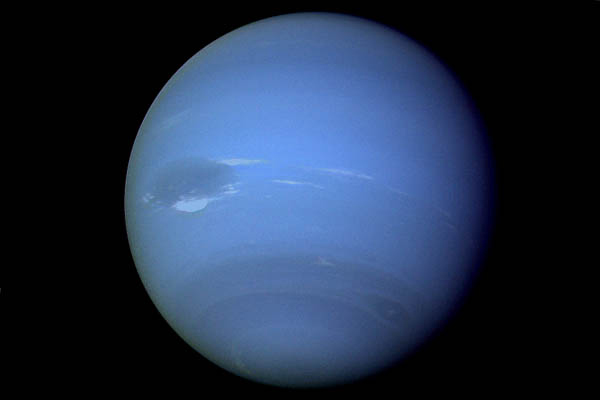Comet Smacked Neptune 200 Years Ago, Data Suggests

Newmeasurements of Neptune's atmosphere by a European space telescope suggest thata comet may have crashed into the gas giant about 200 years ago.
Scientistsanalyzed the composition of Neptune'satmosphere using data from the Herschel space observatory. They found apeculiar distribution of carbon monoxide in the gas giant's atmosphere, whichcould be an indication of an earlier comet impact.
Theresearch is detailed in the July 16 online issue of the journal Astronomy &Astrophysics.
Usingpast knowledge
Othersimilar collisions between comets (or asteroids) and planets helped theastronomers detect the telltale signs of cometary impacts. [Photos:Jupiter Hit By Asteroid or Comet]
Whenpieces of the comet Shoemaker-Levy 9 slammed into Jupiter in 1994, scientists were able toexamine the trajectory and debris to better understand planetary impacts. Instruments aboard the space probes Voyager 2, Galileo and Ulyssesalso documented every detail of the rare incident.
Thedata now helps scientists detect the telltale signs of cometary impacts thathappened many years ago. Comets, which are sometimes described as "dustysnowballs," leave their mark in the atmospheres of gas giants like Jupiterand Neptune in the form of water, carbon dioxide, carbon monoxide, hydrocyanicacid and carbon sulfide. Trace molecules of these compounds can be detected in theradiation emitted by the planets into space.
Breaking space news, the latest updates on rocket launches, skywatching events and more!
InFebruary, scientists from the Max Planck Institute for Solar System Research (MPS)presented strong evidence for a comet impact on Saturn about 230 years ago.That study was published in the February 2010 issue of Astronomy &Astrophysics.
Neptuneas well?
Newmeasurements performed by the Photodetector Array Camera and Spectrometer(PACS) instrument aboard Herschel allowed astronomers to analyze the long-waveinfrared radiation of Neptune. These observations indicate that Neptune may haveexperienced a similar cosmic collision.
Thescientists examined the atmosphereof Neptune, which mainly consists of hydrogen and helium with traces of water,carbon dioxide and carbon monoxide. They detected an unusual distribution ofcarbon monoxide in Neptune's atmosphere, with much higher concentrations in the upper layer,called the stratosphere, compared to the troposphere layer beneath.
"Thehigher concentration of carbon monoxide in the stratosphere can only beexplained by an external origin," said Paul Hartogh, a scientist at MPSand principle investigator of the Herschel science program that examines waterand related chemistry in the solar system. "Normally, the concentrationsof carbon monoxide in troposphere and stratosphere should be the same ordecrease with increasing height."
A cometaryimpact would explain such curious results. The collision forces the comet tofall apart, while the carbon monoxide trapped in the comet's ice is releasedand distributed throughout the stratosphere over the years.
"Fromthe distribution of carbon monoxide we can therefore derive the approximatetime, when the impact took place," said Thibault Cavali?, also from MPS. Thiswould help scientists confirm that a comet hit Neptune around 200 years ago,the researchers added.
Thenew study also appears to disprove a previous theory that tried to explain thestrange distribution of carbon monoxide in Neptune's atmosphere. The oldertheory suggested that a constant flux of tiny dust particles from spaceintroduces carbon monoxide into the gas giant's atmosphere.
But,in Neptune's stratosphere, the scientists also found a higher concentration ofmethane than expected.
What'smethane got to do with it?
OnNeptune, methane operates in similar ways to water vapor on Earth: thetemperature of the tropopause ? a barrier of colder air that separates the troposphere and stratosphere ? determines how much water vapor can rise into thestratosphere.
Ifthis barrier becomes warmer, more gas is able to pass through. On Earth, thetemperature of the tropopause never falls beneath minus 176 degrees Fahrenheit(minus 80 degrees Celsius). On Neptune, however, the tropopause's meantemperature is minus 426 degrees Fahrenheit (minus 219 degrees Celsius).
Thismeans that a gap in the barrier of the tropopause is the likely culprit for theelevated concentration of methane on Neptune.
Atminus 415 degrees Fahrenheit (minus 213 degrees Celsius), the atmosphere atNeptune's southern pole is six degrees warmer than everywhere else, whichallows gas to pass more easily from troposphere to stratosphere. The methane,which scientists think originates from the planet itself, can therefore spreadthroughout the stratosphere.
TheEuropean Space Agency (ESA) launched the Herschel infrared space telescope inMay 2009. The observatory is the largest, mostpowerful infrared telescope in orbittoday.
- Photos:Jupiter Struck by Asteroid or Comet
- Odd Cloud on Neptune Seen Splitting Into Two
- Infographic: Earth's Atmosphere Top to Bottom

Denise Chow is a former Space.com staff writer who then worked as assistant managing editor at Live Science before moving to NBC News as a science reporter, where she focuses on general science and climate change. She spent two years with Space.com, writing about rocket launches and covering NASA's final three space shuttle missions, before joining the Live Science team in 2013. A Canadian transplant, Denise has a bachelor's degree from the University of Toronto, and a master's degree in journalism from New York University. At NBC News, Denise covers general science and climate change.
